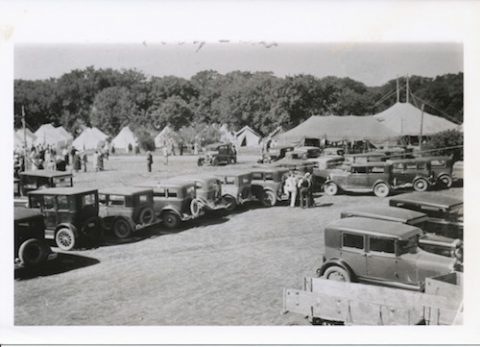On July 24, 1879, at Dakota’s first campmeeting – held on an island in the middle of the Missouri River near Sioux Falls, South Dakota – the Dakota Conference was organized, twenty years before North and South Dakota became states. Present to officiate at the organization was General Conference President James White, who, with his wife Ellen, had traveled the last 25 miles by stagecoach. The meeting drew 200 early Adventists. On the weekend, the numbers swelled to over 1000, with curious onlookers.
In 1873, Scandinavian Adventists began to migrate into the Dakota Territory. Early in 1874, the first Adventist (former Baptist) minister to enter the Dakota Territory, John F. Hanson, arrived at Swan Lake, SD. By 1875, the Swan Lake members had built the first church in the Dakota Territory. Between 1874 and 1879, the Territory’s first three Scandinavian Adventist churches were established: Swan Lake; a Danish church at Sunnydale; and a Swedish group at Big Springs. In 1881, the Milltown Adventist Company became the first German church to be established in the United States. E M. Frederickson wrote to the Review and exclaimed, “I am the only American (English speaking), please send help.”
Theoretically, at least, North Dakota was part of the Dakota Conference in 1879, but for all practical purposes, an almost total lack of transportation and communication links between the two sections made it a completely separate field. To overestimate the importance of the Northern Pacific Railroad in the populating of North Dakota and in the establishing of the Seventh-day Adventist Church in the state is scarcely possible.
On August 6, 1884, George Cidus Tenney, a Wisconsin minister, arrived in Fargo and immediately took steps to organize the scattered believers. On December 6, exactly four months later, G. C. Tenney organized the Fargo Adventist church, the first in North Dakota, with all of the approximately seventy-five Adventists in the state.
The Dakotas have many interesting notables:
- Introduction of systematic benevolence, a forerunner of the current tithing/offering system, affectionately known as “Sister Betsy”
- The beginning of Sunshine Bands, whose purpose was to “do something for somebody everyday”. This was the precursor to the Missionary Volunteers Society, and
- Development of the annual fund raising program of the Adventist church known as Ingathering.

Campmeeting at Jamestown, ND in the early 1920s
